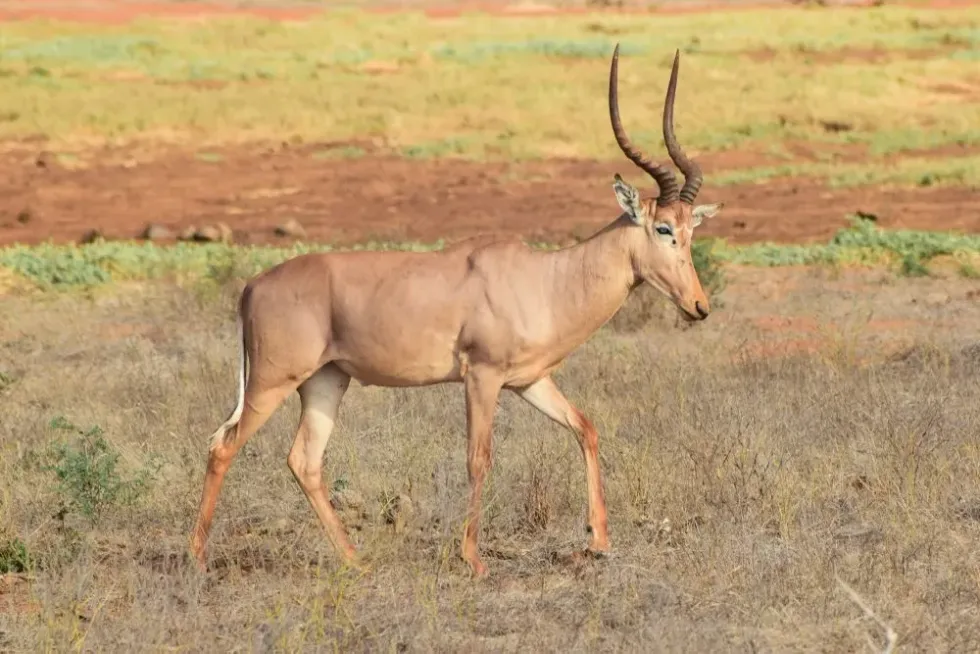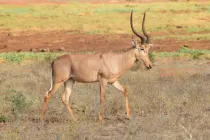The hirola (Beatragus hunteri) is the world’s most endangered antelope. It is also known as Hunter’s hartebeest and Hunter’s antelope. It belongs to the family Bovidae.
The species is native to Kenya and Somalia in Africa. A small population is located in Tsavo East National Park. Very few members of this species remain alive today.
It is the only surviving member of the Beatragus genus. If it becomes extinct, it would be the first mammalian genus in Africa to do so in modern times.
It is also known as the four-eyed antelope due to its pre-orbital glands that look like spectacles. The hirolas use the glands to mark territory. They form groups of 15-40 hirolas and stay together.
The hirola habitat consists of grasslands. There is a need for long-term conservation efforts of this species to protect the natural range of the animals. Predation and poaching have led to a rapid decline in numbers.
If you enjoy reading this article, why not check out more about bontebok and takins?
Hirola Interesting Facts
What type of animal is a hirola?
The hirola or Hunter's hartebeest is a species of antelope that belongs to the Bovidae family.
What class of animal does a hirola belong to?
The hirola (Beatragus hunteri) belongs to the class of mammals in the kingdom of Animalia.
How many hirolas are there in the world?
The hirola is the most endangered antelope in the world. The population has gone down from 15,000 members in the 1970s to less than 500 at present. The rinderpest epidemic has wiped out 90% hirola population. All of the present population lives in the wild.
Where does a hirola live?
The hirola antelope is endemic to only a handful of places in Africa. The primary population of the species is found in the location between Juba River in Somalia and Tana River in Kenya.
In the latter nation, the places where you can spot a hirola are Bura, Galma Galla, and Garsen. About 20 antelopes of this species were brought to the Tsavo East National Park, Kenya in 1963. These were brought from the South Garissa District.
What is a hirola's habitat?
The habitat of the hirola consists of semi-arid grasslands and wooded savannahs. The antelope prefers areas with short grass and dry acacias shrub for living.
The hirola moves from one place to another when the grass becomes tall and carnivores intrude on the area. Light woodlands are also favored grazing lands of the hirola. The vast majority of the population can be found in open grassland that has scattered trees and light bush and is located on well-drained soil.
Who do hirolas live with?
The hirola is found in a herd that contains a single male, a number of females, and young hirolas. The adult males mark their territories with dung and slash the vegetation using their horns.
A herd can also have only males and yearlings. A large herd made of the smaller herds can even consist of hundreds of members depending on the time of the year.
How long does a hirola live?
The average lifespan of the antelope that has been recorded in captivity is 10-15 years. The longevity of the animal in the wild is not known.
How do they reproduce?
The breeding season falls in the range of March to April before the rain begins. The females give birth between October and November as gestation lasts for about seven to eight months.
The breeding system of the hirola is polygynous which means one male can mate with multiple females. After gestation, the female gives birth to one calf.
Very rarely will you see two calves being born. The female antelope becomes sexually mature at about two to three years of age.
The male has to compete with other males and hence do not mate till they are about three or four years old. The females look after the calf that becomes capable of running immediately after birth.
During the first two weeks after giving birth, the female stays apart from the herd and both mother and child are prone to predators in this time. When the calf grows up a little to a yearling, it moves away from the herd and forms another group with other yearlings.
What is their conservation status?
As per the reports of the IUCN Red List of Threatened Species, the hirola antelope is a Critically Endangered species with a decreasing population trend. The number has gone down from 15,000 to under 500 in the past few decades.
A major portion has died from the disease rinderpest that shot down the animals by 90%.
Furthermore, poaching and loss of habitat have contributed to the dwindling numbers of this species. Recently many efforts have been made to take the help of local communities and prevent the animal from becoming extinct.
Hirola Fun Facts
What do hirola look like?
The hirola or Hunter’s hartebeest has a short neck with long legs, a long face and a long body. The colors vary from slate gray to sandy brown. The animal has a white tail and white ears with black tips.
The distinctive feature of the species is the pre-orbital glands under the eyes that look as if the animal is wearing spectacles. Hirola horns are present in either sex and are curved in shape. The horns grow to lengths of 27.6 in (70 cm).
How cute are they?
Whether the hirola is a cute animal or not is a subjective matter but the brown color certainly includes some shades of cuteness to the species.
How do they communicate?
During the formation of herds, the males compete with one another to get access to the females. This is done through preorbital gland secretions as well as posturing. The females communicate with the males through chemical cues.
How big is a hirola?
The hirola size lies in the range of 47.2-80.7 in (120-205 cm). The hirola animal stands as high as 49.2 in (125 cm) on its shoulder while the tail length of a hirola varies between 3.9-23.6 in (10-60 cm).
The Saiga antelope of Asia is a little smaller than the hirola with its maximum body length to have been recorded being 55 in (140 cm).
How fast can a hirola run?
Unfortunately, there is not much data to determine the speed of a hirola. Being an antelope species, it can be said that the hirola can run to avoid predators.
How much does a hirola weigh?
The hirola is a medium-sized antelope whose weight falls in the range of 143.2-341.4 lb (65-155 kg) on average. It is 10 times heavier than the Chinese water deer whose average weight is only 31 lb (14 kg).
What are the male and female names of the species?
There are no distinct names for the males and females of this animal.
What would you call a baby hirola?
A baby hirola is called a calf and sometime later, a yearling.
What do they eat?
Hirolas are strictly herbivores. The diet of these animals consists of short grass and forbs. They move to a different grazing land if the grass becomes too tall.
The feeding takes place mainly in the early morning and early evening times of the day. The animal can survive without drinking water for long periods by storing fats and avoiding activities like running. The threat of predation looms large over the hirola which faces attacks from animals like lions and cheetahs.
Are they dangerous?
No, you would not associate the word danger with the hirola antelopes. They are harmless wildlife.
Would they make a good pet?
The hirola is the world's rarest antelope species and it is suited for a life in the wild grasses. You should not even think about getting the antelopes as pets.
Did you know...
Twilight is the preferred feeding time for the hirola as the danger of being preyed upon is less.
The hirola population range has reduced so drastically that the need to form conservation groups is very vital.
Hartebeest and hirola are similar antelopes who belong to the Alcelaphinae subfamily.
Are hirolas endangered?
Hirolas are the world’s most endangered antelopes. The present population of this animal is less than 500 and is mainly found in the Kenya-Somalia border. Garissa County in Kenya has the highest population.
The rinderpest disease in the 1980s killed 90% of the total 15,000 hirolas. The numbers could not rise again after the eradication of rinderpest.
Overgrazing by other wildlife and domestic animals has led to a shortage in their diet of grasses. Predation by Africa’s wild carnivores like lions, wild dogs and cheetahs has further reduced the numbers tremendously. A number of droughts leading to the loss of grasslands have also caused death to the antelopes.
A few of these antelopes were brought to Tsavo East National Park. To prevent hirola extinction, Kenya Wildlife Service, the Northern Rangelands Trust and Ishaqbini Community Conservancy came together in 2012 to establish a protected area that is predator-proof for the hirola.
What is hirola conservation Kenya?
The Hirola Conservation Program (HCP) is based out of Garissa County, Kenya. The main objective of the organization is hirola conservation which is very important today.
Large areas of grasslands are being restored by the HCP in areas where you will find hirolas. The protection of elephants is also looked after by HCP as the elephants help to control tree cover whose loss is harmful to the hirolas.
Here at Kidadl, we have carefully created lots of interesting family-friendly animal facts for everyone to discover! Learn more about some other mammals including deer facts, or fallow deer fun facts pages.
You can even occupy yourself at home by coloring in one of our free printable deer coloring pages.
Second image by JRProbert.









